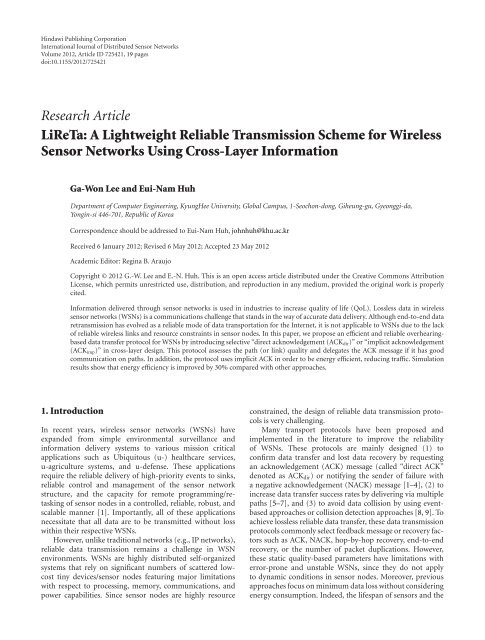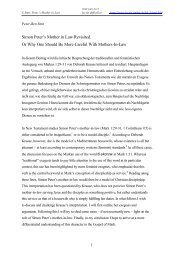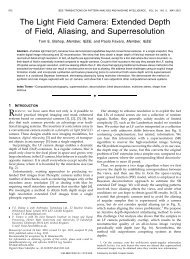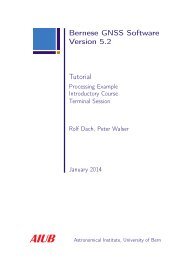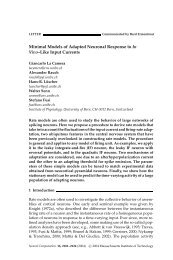Deploying Real-Life WSN Applications: Challenges ... - IAM - CDS
Deploying Real-Life WSN Applications: Challenges ... - IAM - CDS
Deploying Real-Life WSN Applications: Challenges ... - IAM - CDS
Create successful ePaper yourself
Turn your PDF publications into a flip-book with our unique Google optimized e-Paper software.
Hindawi Publishing Corporation<br />
International Journal of Distributed Sensor Networks<br />
Volume 2012, Article ID 725421, 19 pages<br />
doi:10.1155/2012/725421<br />
Research Article<br />
LiReTa: A Lightweight Reliable Transmission Scheme for Wireless<br />
Sensor Networks Using Cross-Layer Information<br />
Ga-Won Lee and Eui-Nam Huh<br />
Department of Computer Engineering, KyungHee University, Global Campus, 1-Seochon-dong, Giheung-gu, Gyeonggi-do,<br />
Yongin-si 446-701, Republic of Korea<br />
Correspondence should be addressed to Eui-Nam Huh, johnhuh@khu.ac.kr<br />
Received 6 January 2012; Revised 6 May 2012; Accepted 23 May 2012<br />
Academic Editor: Regina B. Araujo<br />
Copyright © 2012 G.-W. Lee and E.-N. Huh. This is an open access article distributed under the Creative Commons Attribution<br />
License, which permits unrestricted use, distribution, and reproduction in any medium, provided the original work is properly<br />
cited.<br />
Information delivered through sensor networks is used in industries to increase quality of life (QoL). Lossless data in wireless<br />
sensor networks (<strong>WSN</strong>s) is a communications challenge that stands in the way of accurate data delivery. Although end-to-end data<br />
retransmission has evolved as a reliable mode of data transportation for the Internet, it is not applicable to <strong>WSN</strong>s due to the lack<br />
of reliable wireless links and resource constraints in sensor nodes. In this paper, we propose an efficient and reliable overhearingbased<br />
data transfer protocol for <strong>WSN</strong>s by introducing selective “direct acknowledgement (ACK dir )” or “implicit acknowledgement<br />
(ACK imp )” in cross-layer design. This protocol assesses the path (or link) quality and delegates the ACK message if it has good<br />
communication on paths. In addition, the protocol uses implicit ACK in order to be energy efficient, reducing traffic. Simulation<br />
results show that energy efficiency is improved by 30% compared with other approaches.<br />
1. Introduction<br />
In recent years, wireless sensor networks (<strong>WSN</strong>s) have<br />
expanded from simple environmental surveillance and<br />
information delivery systems to various mission critical<br />
applications such as Ubiquitous (u-) healthcare services,<br />
u-agriculture systems, and u-defense. These applications<br />
require the reliable delivery of high-priority events to sinks,<br />
reliable control and management of the sensor network<br />
structure, and the capacity for remote programming/retasking<br />
of sensor nodes in a controlled, reliable, robust, and<br />
scalable manner [1]. Importantly, all of these applications<br />
necessitate that all data are to be transmitted without loss<br />
within their respective <strong>WSN</strong>s.<br />
However, unlike traditional networks (e.g., IP networks),<br />
reliable data transmission remains a challenge in <strong>WSN</strong><br />
environments. <strong>WSN</strong>s are highly distributed self-organized<br />
systems that rely on significant numbers of scattered lowcost<br />
tiny devices/sensor nodes featuring major limitations<br />
with respect to processing, memory, communications, and<br />
power capabilities. Since sensor nodes are highly resource<br />
constrained, the design of reliable data transmission protocols<br />
is very challenging.<br />
Many transport protocols have been proposed and<br />
implemented in the literature to improve the reliability<br />
of <strong>WSN</strong>s. These protocols are mainly designed (1) to<br />
confirm data transfer and lost data recovery by requesting<br />
an acknowledgement (ACK) message (called “direct ACK”<br />
denoted as ACK dir ) or notifying the sender of failure with<br />
a negative acknowledgement (NACK) message [1–4], (2) to<br />
increase data transfer success rates by delivering via multiple<br />
paths [5–7], and (3) to avoid data collision by using eventbased<br />
approaches or collision detection approaches [8, 9]. To<br />
achieve lossless reliable data transfer, these data transmission<br />
protocols commonly select feedback message or recovery factors<br />
such as ACK, NACK, hop-by-hop recovery, end-to-end<br />
recovery, or the number of packet duplications. However,<br />
these static quality-based parameters have limitations with<br />
error-prone and unstable <strong>WSN</strong>s, since they do not apply<br />
to dynamic conditions in sensor nodes. Moreover, previous<br />
approaches focus on minimum data loss without considering<br />
energy consumption. Indeed, the lifespan of sensors and the


